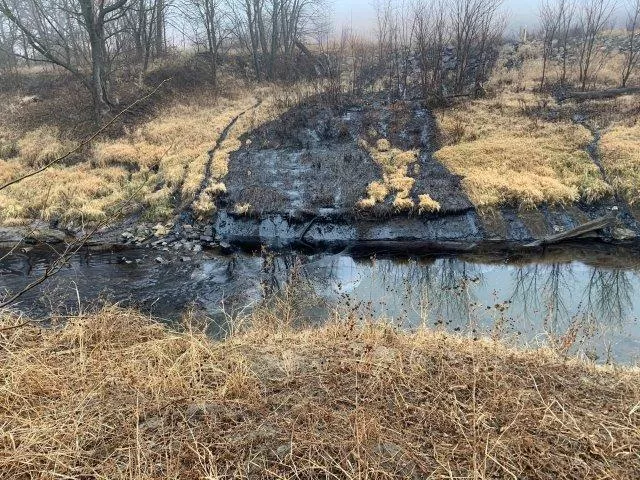
Keystone Pipeline Oil Spill, Washington, Kansas | EPA photo
By Zack Pistora, Sierra Club Kansas Lobbyist
On December 7th, 2022, Washington County, Kansas became ground zero to the largest oil spill yet from the Keystone Pipeline. An estimated 14,000 barrels (nearly 600,000 gallons) of tar sands oil – diluted bitumen or “dilbit” – saturated a hillside and drained into a four-mile stretch of Mill Creek. Environmental groups, including Sierra Club, have long warned that major pipeline breaks spilling nasty tar sands oil was never a matter of if, but when and how bad.
The disaster, termed the “Milepost 14 incident” by Keystone Pipeline’s operator TC Energy (formerly TransCanada), is the 23rd instance the 2,687-mile hazardous liquid Keystone Pipeline system has failed since its operation began in 2010; the 6th time in Kansas. This latest spill is larger than all the previous 22 spills combined and ranks in the top 5 inland spills in the United States in the last two decades and in the upper ranks of all-time.
According to a 2021 U.S. Governmental Accountability Office report, four of the five largest Keystone pipeline spills have occurred within the last 6 years. The previous large spills involved defects in the original pipe manufacturing or design, or fatigue cracks caused by issues in the construction, installation, or fabrication of the pipeline. Sustained pipeline pressure, continued corrosion, and environmental changes over time will only make these design, material, or installation problems worse and more frequent.
“Nothing to See Here”
While the recent tar sands spill initially made national and international news, updates have been scarce – a deliberate case of “out of sight, out of mind.” Access points to view the spill site were quickly blocked off, a no-fly zone was established (and since extended), and to my knowledge, no on-scene press conferences have taken place. TC Energy and emergency responders may want to protect the public from risk of exposure to hazardous materials and to reduce distractions in the cleanup effort. But it's likely that the Canadian-based fossil fuel company doesn't want the public to see the ugly side of its business. There are photos of the cleanup crews on TC Energy’s incident website, but few pictures showing the actual oil. When state officials were invited to a VIP visit at the spill site, the best views were provided by a drone video inside a trailer.
Immediately after the spill, the U.S. Pipeline and Hazardous Materials Safety Administration issued a Corrective Action Order (CAO) that called for a shutdown of the affected segment, a review of in-line inspection results, mechanical and metallurgical testing, a Root Cause Failure analysis, a Remedial Work Plan, a CAO Documentation Report, a Restart Plan, and more. However, none of this required documentation seems to be posted on the company’s incident website. The company signed a Consent Order with the Environmental Protection Agency (EPA) which outlined requirements of the cleanup, yet that document is not posted on the incident’s landing pages of TC Energy or EPA. The only information on the KS Dept. of Health and Environment’s website relating to the environmental disaster is a stream advisory, despite public reporting that toxic chemicals have been found downstream of the containment zone. Kansas Dept. of Wildlife and Parks has been assessing the spill’s impact to wildlife, which includes deaths of fish, mussels, and mammals, but the agency has not issued any final reports. Finally, to date, no informational hearing on the spill has been held at the Kansas Legislature.
Unanswered questions, including Root Cause Analysis
While it only took three weeks after the spill for TC Energy to get the federal greenlight to restart the flow of tar sands oil through the pipeline, Kansans still don’t know why the pipeline failed. TC Energy reports that it has recovered 90% of the estimated oil leaked, amounting to over a half million gallons total. However, there is no clear timeline to complete the cleanup, only that it will take “several weeks.”
Finally, how can we be sure that another major pipeline spill isn’t waiting to happen? Pipeline integrity tests were said to have ensured the pipeline was safe prior to this latest spill. However, the Kansas spill is greater than all the previous spills combined, the frequency of large spills is increasing, and the cause of the failure has yet to be identified. The public, the regulatory agencies and the company should be concerned about the pipeline's future.
This disaster is eye-opening. There are serious risks associated with our oil and gas delivery systems. Pipeline failures and tanker spills are only part of the problem. Burning, refining, and fracking for oil and gas collectively cause air, water, and atmospheric pollution every single day, but aren't as obvious as oil spills. All of us are absorbing the costs of oil and gas dependency with price shocks at the pump and on our energy bills, while major oil companies report record profits. More people are realizing that there are better and more cost-effective ways to achieve our energy needs without the pollution and social costs of fossil fuels.
Sierra Club on watch
From the onset, the Sierra Club has been active in monitoring and speaking out on the recent Keystone Pipeline disaster. Sierra Club issued a press statement immediately and over the last two months the Kansas Chapter has been responding to dozens of media inquiries, as well as engaging area members. We will continue to press for more answers, monitor the situation, and advocate for the transition away from fossil fuels.